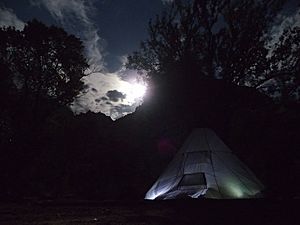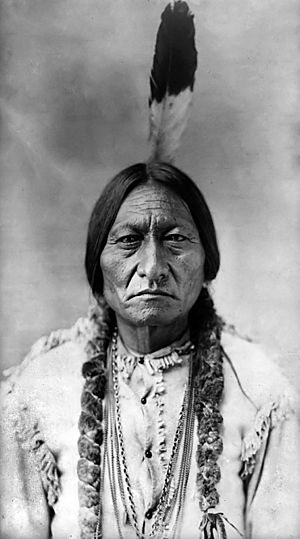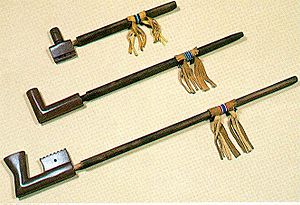Shaking tent ceremony facts for kids
The Shaking Tent ceremony is a special event practiced by some Indigenous peoples in North America. It helps people connect with the spirit world. This ceremony creates a way for the human world and the spirit world to communicate. Special tents or lodges are built for these events. A shaman, or spiritual leader, guides the ceremony. They use different practices, rituals, and materials to perform it. This ceremony was common among certain Indigenous tribes long ago. It is still practiced in parts of the continent today.
Contents
What Happens in the Ceremony?
When a tribe needed answers, their shaman would ask the spirits for help. The ceremony usually takes place at night. It happens inside a round tent. The shaman enters this tent. Some stories say the shaman was tied up inside. Once in the tent, the shaman might use a pipe or sing songs. These actions help invite spirits to enter.
When spirits arrive, the tent begins to shake strongly. Other voices, besides the shaman's, can be heard. The shaman then receives the answers needed. After the ceremony, the shaman comes out, often feeling very tired. The ceremony can last for many hours. Many people can watch from outside the tent. This unique event helps tribes get important information. It guides them in making decisions for their future.
A Look at the History
The exact start of the Shaking Tent ceremony isn't fully known. One of the first times it was seen by outsiders was in the early 1600s. A man named Samuel Champlain witnessed it. He was traveling in what is now Canada for France. Some believe this was one of the first Indigenous ceremonies written about in North America.
Many written accounts describe this ceremony. Most agree the tent is round and covered with material. They often mention the strong shaking and sounds from inside. These stories can differ based on the tribe's style. They also depend on the person writing the account. However, most accounts share a main idea.
The Ojibwe tribe used this ceremony in the fall and spring. Other tribes would gather and use it to influence those around them. The Cree tribe once called it the Bow Pole Dance. More recently, they know it as a Spirit Lodge. The Cree used the ceremony to teach their children. It helped them understand the power and usefulness of such events. They also used it to help cure sickness. There were even reports of serious illnesses being helped. The Cree used this ceremony more often in the 1960s. They sought help from other tribes' strong spiritual leaders for healing. Today, the ceremony is still used. It is not as openly accepted as it once was. However, it remains a big part of their culture. Some people today believe the ceremony has changed. Others still see it as part of their identity. They believe it should be used to help their tribes. Those who want to keep their culture alive work to remember and continue this ceremony.
Tribes That Practice It
Many tribes across Canada and the Northern United States practice this ceremony. It is a way to connect with their spiritual side. It helps them find answers to life's questions. The Algonquin tribe is one of the most well-known. Some say they were the most important tribe to use this ceremony. Other tribes include the Gros Ventres, Assiniboine, Blackfeet, Ojibwe, and Cree. Several other tribes in Northern Canada and Quebec also practice it.
What is Similar?
The main goal of this ceremony is to bring spirits into the tent. This helps gain knowledge about a mystery or event. Spirits enter and leave the tent through the top. The shaman is the only one who understands and talks with the spirits. They are not controlled by the spirit. Instead, they act as a spokesperson.
The ceremony starts at night. The shaman smokes a pipe and sings songs to call the spirits. The tent shakes strongly for hours. This happens while the shaman and spirit communicate. The shaking can be so intense it seems the tent will fall. But it never does. People near or in the tent often hear different voices. The shaman leaves the tent when all questions are answered. They are usually very tired after the long talk. Knowledge gained from this ceremony helps the tribe. It can range from finding lost items to understanding the future.
What is Different?
Across the large area where this ceremony is performed, there are differences between tribes. These differences are usually small details. One difference is the use of food. Some tribes bring a plate of food for the spirit. The spirit can eat and enjoy it when sharing knowledge.
Another difference is the number of spirits. Some tribes have only one spirit come to the tent. This spirit is often related to the shaman. Other tribes might have many spirits enter. This could be one human spirit and several animal spirits. Some tribes allow other people in the tent to watch. Others believe only the shaman should perform the ceremony.
Shamans can enter the tent in different ways. Some tribes have the shaman enter with a pipe. Others tie up the shaman with different materials before they go in. Finally, humor can be a difference. Tribes with multiple spirits often have a more joking tone. The spirits might playfully talk with the shaman. Tribes with only one spirit usually have no humor or playful talk. The spirit is there only to help the shaman find the knowledge they seek. The type of knowledge sought depends on the tribe's needs. It also depends on how they typically use the Shaking Tent ceremony.
The Role of the Shaman
Connecting to the spirit world was important for everyone in the tribes. They connected with their ancestors for guidance and support. This also helped keep their identity as members of a Native American tribe. While ceremonies were open to all, how deeply someone participated could depend on their wealth. Wealthier people could afford the most respected shamans. They also had access to the best special plants and tents. Some tents were more like log cabins than teepees. Less wealthy people used common shamans. They might have smaller, simpler tents. Wealth did not mean someone was more worthy. However, wealthier people could perform the ceremony more often. This might lead to a stronger connection to the spirit world.
Shamans are important members of the tribe. They are the spiritual leaders and guides to the tribe's ancestors. Shamans can be men or women. They need to have the right knowledge and spiritual connection. This allows them to perform the rituals. Indigenous tribes believe every human, plant, and animal has a spirit. A shaman can more easily recognize and talk with these spirits. Connecting to other spirits and the spirit world helps people's mental well-being. It gives them a place and purpose in their community. Connecting to spirits is also important because it links people to the Earth. It creates a relationship with nature and the materials they use. It also provides a direct link to their ancestors and traditions. These traditions might otherwise be forgotten over time.
Tools for the Ceremony
Special Plants
Long ago, special plants were used in these ceremonies. They were seen as a way to enter the spirit world. Each plant had a different level of importance and use. Many rituals involved the use of certain plants. A shaman was often like a spiritual expert on plants. The plants were used in various ways. They were often smoked. Each plant had a different purpose. Some might help remove negative spirits. Others might help calm or ground spirits. Plants not only helped people spiritually. Ceremonies with plants were also performed to help physical health. The information available today doesn't detail the exact plants used. However, the knowledge these people have about plants could help modern medicine.
The Tents Used
To perform a Shaking Tent ceremony, different types of structures could be used. Most tents or lodges were built in a round shape. The frame was made from sticks. It was then covered with canvas or other material. The material depended on what was available. The tents were made to offer sacrifices. They were also built to hold and filter the smoke and incense used. The tents and lodges were not very fancy. However, stronger, better, and more sacred materials were used for wealthier people's tents. These structures provided a sacred place. It was a place away from the everyday world. Here, people could connect with spirits and find healing.




